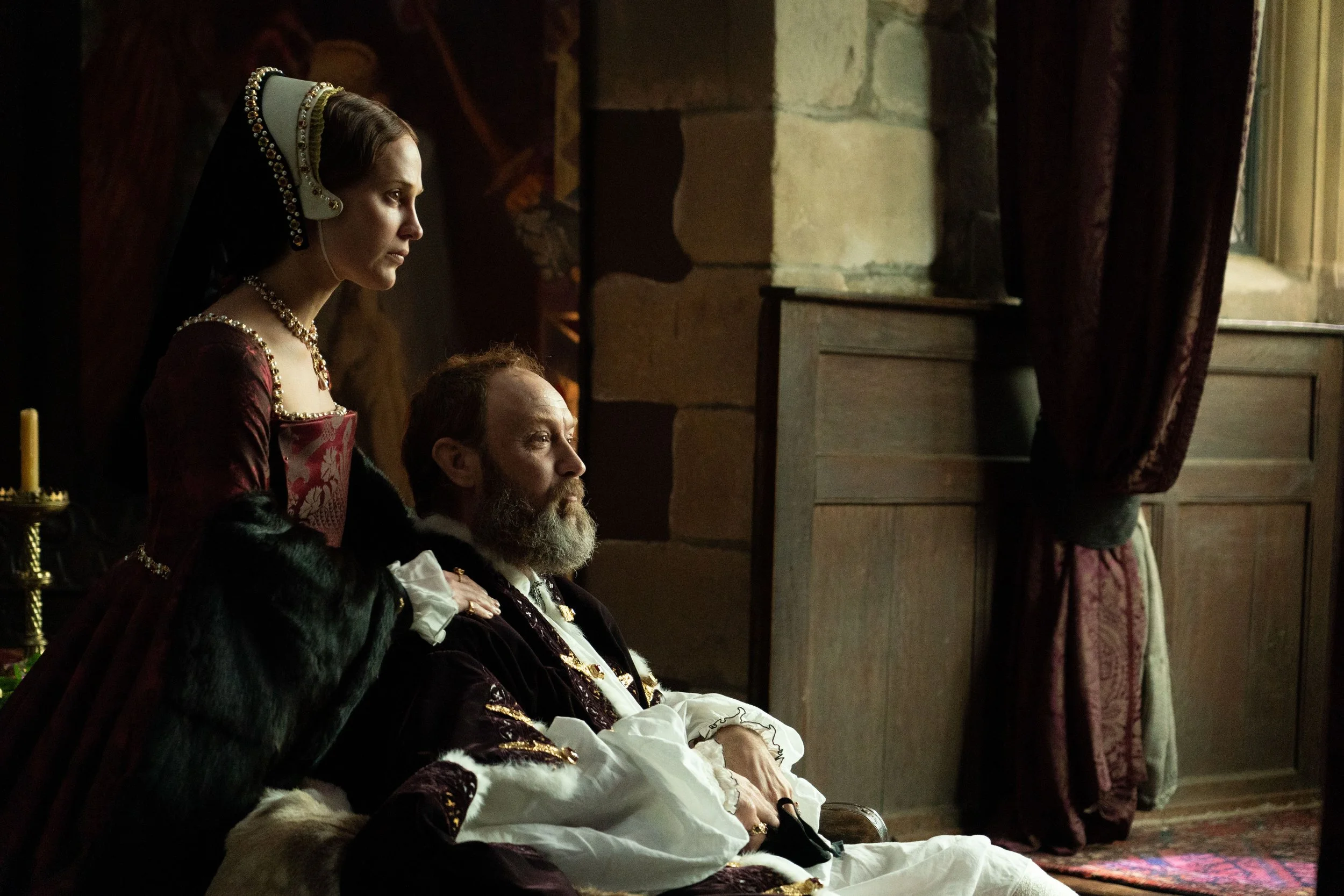Film Review: Firebrand (2024)
Jude Law and Alicia Vikander in Firebrand
Photo Credit: Larry Horricks
Firebrand Film Review
Director Karim Aïnouz
Written by Trip Avis
Firebrand, the first English-language film from Brazilian director Karim Aïnouz, has all the splashy Hollywood costume drama trappings. It has A-list stars, including Academy Award winner Alicia Vikander as the queen who survived, Katherine Parr, and usual heartthrob Jude Law playing against type as a cantankerous, rotund, and Nixon-level-paranoic Henry VIII. The costuming, expertly designed by Michael O’Connor, is opulent and historically accurate (see: French Hood). But The Other Boleyn Girl, it is not. Rather than pursuing the Tudor court intrigue — a well-tread path in pop culture — from a melodramatic or even sexualized Hollywood perspective, what Aïnouz has crafted is a tense psychological thriller and a startling portrait of marital domestic abuse. The film’s opening lines, “In a rotten, blood-soaked, island kingdom, there once was a queen by the name of Katherine Parr…,” are chillingly recited by her famous stepdaughter, the then-Princess Elizabeth (newcomer Junia Rees in her feature debut). We learn that the England we visit in Firebrand is a tired, creaking giant, a shell of its former robust self — not unlike its once chivalric fairytale king.
Jude Law and Alicia Vikander in Firebrand
Photo Credit: Larry Horricks
Perhaps the most defining factor of the film lies in the fact that Aïnouz approaches the subject matter not from a staid, scholarly docudrama perspective or the aforementioned ‘bodice ripper’ slant but as a thriller. When presented with the facts, it seems an almost obvious choice of genre: a woman finds herself in a precarious position — on the precipice of her downfall — her life threatened by the man meant to love and protect her. Firebrand is no colorful spectacle despite the elegant gowns and jewels, bountiful feasting, and courtly dances. Cinematographer Hélène Louvart leaches the color from the screen with low natural lighting and tight, abrasive framing, following the increasingly distraught Katherine like a relentless fiend. There is a method to the madness: a mounting claustrophobia that the viewer potently feels. But the film does not linger endlessly in its morbid dourness; moments of bawdy comedy shine through. In one scene, Henry’s groans of pain during the treatment of his abscessed leg merge seamlessly into sexual moans as he engages in an awkward tryst with his wife.
This is not Alicia Vikander’s first time playing an aristocrat: she garnered critical notice for portraying the equally tragic Danish queen Caroline Mathilde in A Royal Affair and Russian noblewoman Kitty Shcherbatskaya in Anna Karenina (both 2012). It is a role she shrugs into convincingly. Whether she is portraying Katherine’s smug hauteur as she presides as regent over her husband’s court, her tender mothering behind closed doors to her traumatized stepchildren, or her chastened terseness as she warns her childhood friend, preacher Anne Askew (The Crown’s Erin Doherty), Vikander plays a woman of many faces and dispositions, a role and life fractured beneath the fist of her demanding, childlike husband.
Alicia Vikander in Firebrand
Photo Credit: Larry Horricks
For his part, Jude Law disappears into the role of Bluff King Hal with the help of major leg padding and even a bottom double (a moment of unintended comedy). Costuming, however, does not discount the fearsome rancor he brings to the role of the preening, mercurial Henry VIII in perhaps his best and most multi-faceted role in years. One can feel the pain — both physical and mental — of a man grappling with his mortality while sowing the seeds of his family’s, kingdom’s, and own undoing. Beneath Law’s displays of kingly bravado and irritability, a sadness emanates from deep within this velvet-clad, codpiece-wearing man.
Body horror is a key, unexpected element in the film. Aïnouz deftly employs the motif to the film’s benefit, transposing a visceral Cronenbergian horror to Tudor England. It further strips away the veneer of fairytale regality, juxtaposing the lushness of the costuming and sets with a wincingly human gore. In one scene, Katherine miscarries her long-desired child on a rug beside her bed, reeling in a private tragedy that will impact the stability of a kingdom. She hisses through her tears for her child to stay inside her as she bleeds out, dying her elegant frock a crimson red. Witnessing up close the corpus of these legendary royal figures — the stink, the blood, the rot — allows us to connect with them in an unexpectedly human way. Henry orders his wife to place maggots on his open wound. As she does so, she begins to laugh. When he angrily inquires about the humor of the situation, she kisses his gout-ridden leg and whispers that she is pregnant. It is disgusting, but also strangely tender. Like the rest of the film, a heavy dread looms restlessly over them like a moth-bitten ermine cloak.
Patsy Ferran and Junia Rees in Firebrand
Photo Credit: Larry Horricks










